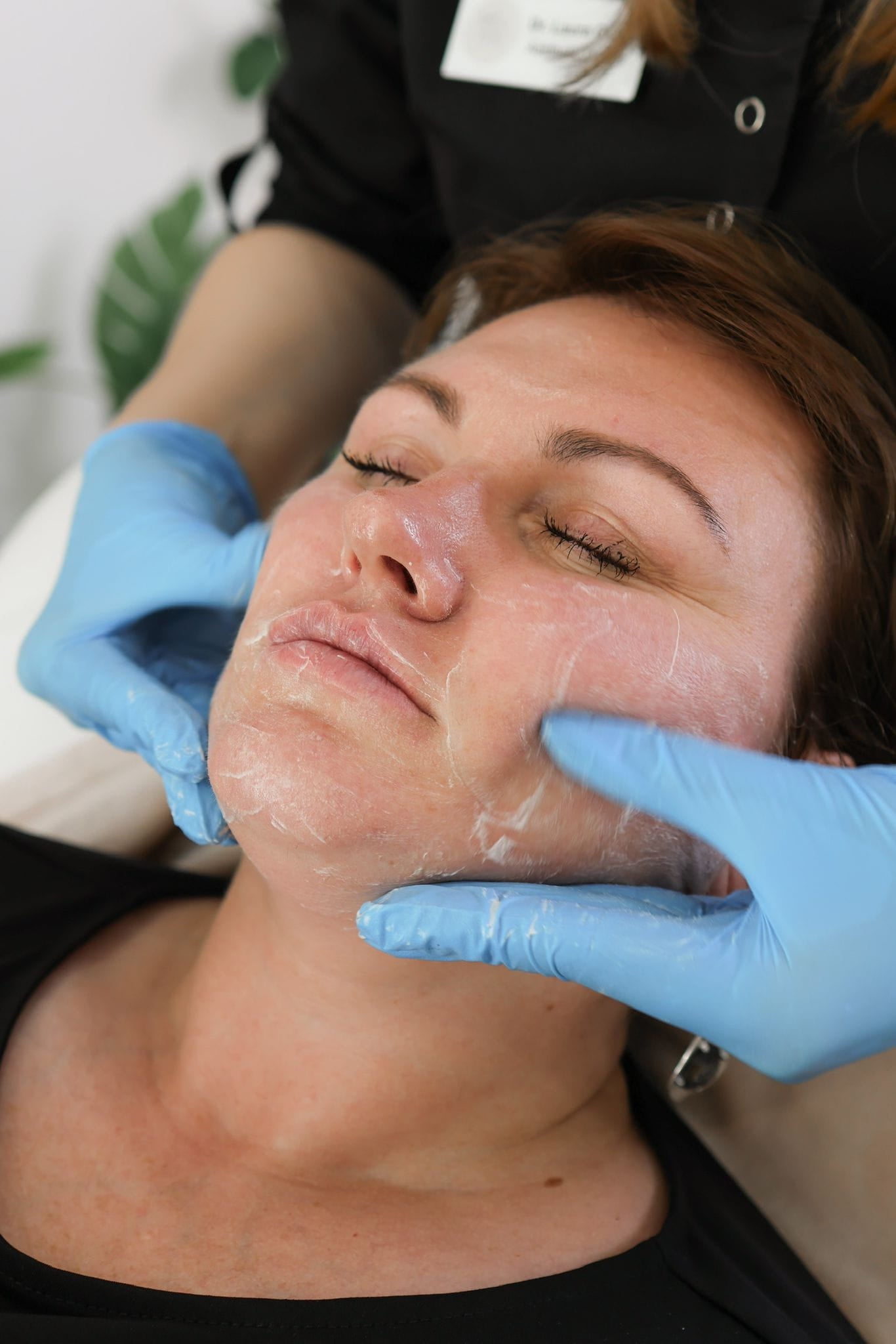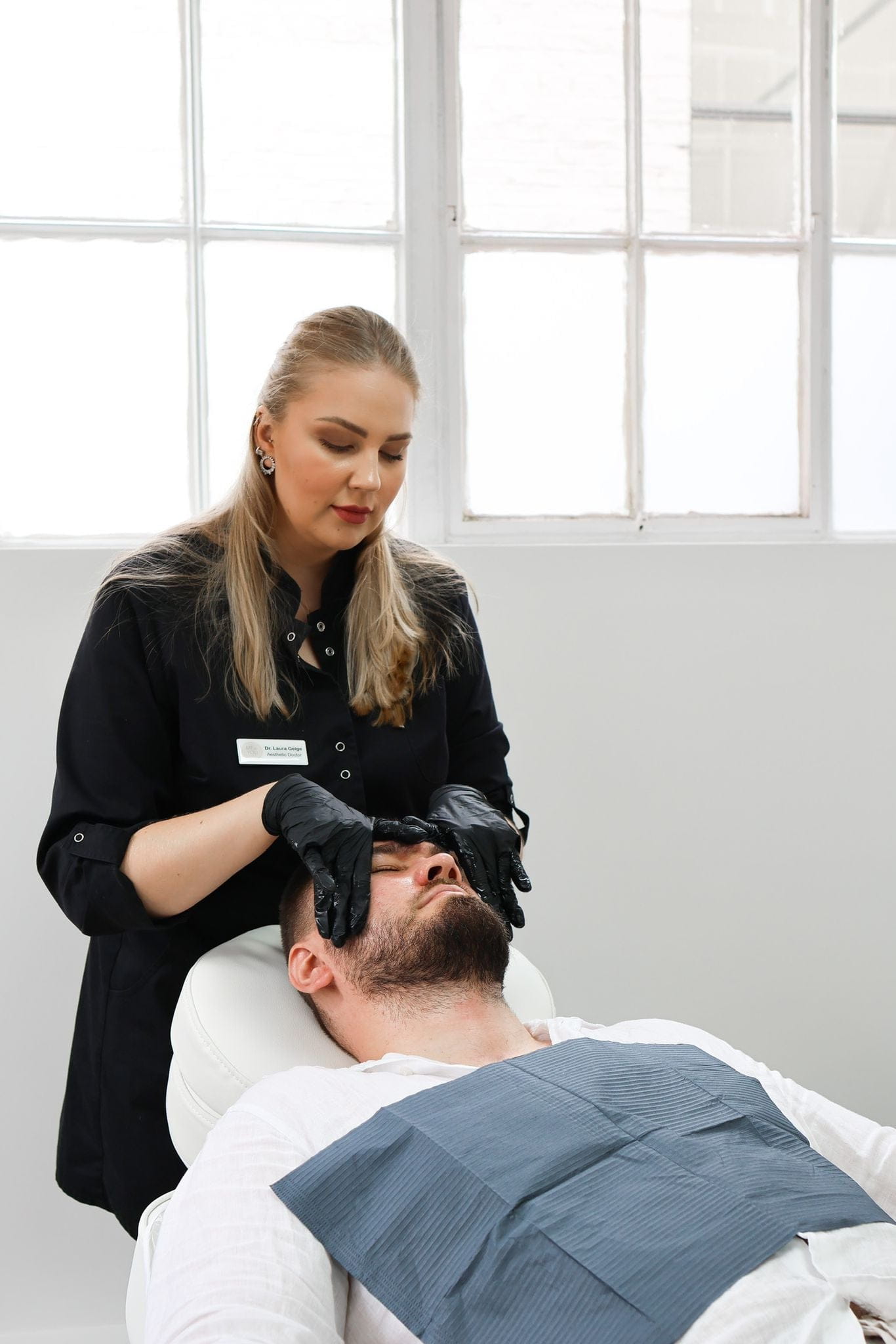Cosmelan Depigmentation Peel Process
The Cosmelan Depigmentation Peel is a professional treatment designed to address pigmentation concerns, such as hyperpigmentation, melasma, and sun spots. This chemical peel utilizes a potent blend of ingredients that work together to inhibit melanin production, reduce existing pigmentation, and promote a more even skin tone.
Ingredients and Formulation
The Cosmelan Depigmentation Peel works by targeting the melanin-producing cells in the skin called melanocytes. Melanin is the pigment responsible for skin color, and when overproduced, it can lead to unwanted dark patches or spots.
The peel’s formulation contains a combination of ingredients including kojic acid, azelaic acid, phytic acid, retinol, and glutathione. Each ingredient plays a specific role in reducing pigmentation. Kojic acid and azelaic acid inhibit melanin production, while phytic acid works to lighten existing pigment. Retinol stimulates cell turnover, helping to exfoliate the skin and remove pigmented cells, and glutathione acts as an antioxidant to protect against further damage.
The Cosmelan Peel is typically applied in multiple layers by a qualified practitioner. The peel then remains on the skin for several hours before being removed, allowing the active ingredients to penetrate deeply and work their magic. Following the treatment, a post-peel skincare regimen is essential to maintain results and protect the newly revealed skin.
Application Procedure
The Cosmelan Depigmentation Peel is a multi-step process designed to target hyperpigmentation concerns. During the application procedure, a qualified practitioner carefully applies multiple layers of the Cosmelan peel solution to the affected areas of the skin.
After application, the peel remains on the skin for several hours, allowing the potent blend of ingredients to penetrate deeply and work their way into the deeper layers of the epidermis. This extended contact time is crucial for achieving effective pigmentation reduction.
The Cosmelan Depigmentation Peel is not a one-time treatment but rather a series of sessions spaced out over time. The exact number of sessions required will vary depending on the severity of the pigmentation concerns and individual skin type.
Following each peel session, post-treatment care instructions are provided to help maintain results and minimize potential side effects. This typically involves using specific moisturizers, sunscreens, and avoiding certain activities that could irritate the newly treated skin.
Reaction Time and Aftercare Instructions

The Cosmelan Depigmentation Peel is a professional treatment designed to address pigmentation concerns such as hyperpigmentation, melasma, and sun spots.
This chemical peel utilizes a potent blend of ingredients that work together to inhibit melanin production, reduce existing pigmentation, and promote a more even skin tone.
The Cosmelan Depigmentation Peel works by targeting the melanin-producing cells in the skin called melanocytes. Melanin is the pigment responsible for skin color, and when overproduced, it can lead to unwanted dark patches or spots.
The peel’s formulation contains a combination of ingredients including kojic acid, azelaic acid, phytic acid, retinol, and glutathione. Each ingredient plays a specific role in reducing pigmentation. Kojic acid and azelaic acid inhibit melanin production, while phytic acid works to lighten existing pigment. Retinol stimulates cell turnover, helping to exfoliate the skin and remove pigmented cells, and glutathione acts as an antioxidant to protect against further damage.
The Cosmelan Peel is typically applied in multiple layers by a qualified practitioner. The peel then remains on the skin for several hours before being removed, allowing the active ingredients to penetrate deeply and work their magic. Following the treatment, a post-peel skincare regimen is essential to maintain results and protect the newly revealed skin.
The Cosmelan Depigmentation Peel is a multi-step process designed to target hyperpigmentation concerns. During the application procedure, a qualified practitioner carefully applies multiple layers of the Cosmelan peel solution to the affected areas of the skin.
After application, the peel remains on the skin for several hours, allowing the potent blend of ingredients to penetrate deeply and work their way into the deeper layers of the epidermis. This extended contact time is crucial for achieving effective pigmentation reduction.
The Cosmelan Depigmentation Peel is not a one-time treatment but rather a series of sessions spaced out over time. The exact number of sessions required will vary depending on the severity of the pigmentation concerns and individual skin type.
Following each peel session, post-treatment care instructions are provided to help maintain results and minimize potential side effects. This typically involves using specific moisturizers, sunscreens, and avoiding certain activities that could irritate the newly treated skin.
Mechanism of Action
Understanding how a treatment works is key to appreciating its effectiveness. The Cosmelan Depigmentation Peel addresses pigmentation issues like hyperpigmentation, melasma, and sun spots through a carefully orchestrated mechanism of action.
Tyrosine Inhibition
The mechanism of action behind the Cosmelan Depigmentation Peel centers on inhibiting melanin production.
Melanin is the pigment responsible for skin color, and excessive melanin production leads to dark spots and patches. The peel’s ingredients, such as kojic acid and azelaic acid, directly target tyrosinase, the enzyme responsible for catalyzing melanin synthesis. By inhibiting tyrosinase activity, these compounds effectively reduce melanin formation, leading to a lighter complexion.
In addition to suppressing melanin production, the Cosmelan Peel also employs other mechanisms to combat pigmentation. Phytic acid helps lighten existing pigment, while retinol promotes cell turnover and exfoliation, aiding in the removal of pigmented cells.
Melanin Production Reduction
The mechanism of action behind the Cosmelan Depigmentation Peel centers on inhibiting melanin production.
Melanin is the pigment responsible for skin color, and excessive melanin production leads to dark spots and patches. The peel’s ingredients, such as kojic acid and azelaic acid, directly target tyrosinase, the enzyme responsible for catalyzing melanin synthesis. By inhibiting tyrosinase activity, these compounds effectively reduce melanin formation, leading to a lighter complexion.
In addition to suppressing melanin production, the Cosmelan Peel also employs other mechanisms to combat pigmentation. Phytic acid helps lighten existing pigment, while retinol promotes cell turnover and exfoliation, aiding in the removal of pigmented cells.
Exfoliation Effects
The mechanism of action behind the Cosmelan Depigmentation Peel centers on inhibiting melanin production.
Melanin is the pigment responsible for skin color, and excessive melanin production leads to dark spots and patches. The peel’s ingredients, such as kojic acid and azelaic acid, directly target tyrosinase, the enzyme responsible for catalyzing melanin synthesis. By inhibiting tyrosinase activity, these compounds effectively reduce melanin formation, leading to a lighter complexion.
In addition to suppressing melanin production, the Cosmelan Peel also employs other mechanisms to combat pigmentation. Phytic acid helps lighten existing pigment, while retinol promotes cell turnover and exfoliation, aiding in the removal of pigmented cells.
Benefits and Results
The Cosmelan Depigmentation Peel offers several benefits for individuals seeking to address pigmentation concerns. By inhibiting melanin production, reducing existing pigmentation, and promoting a more even skin tone, this treatment can significantly improve the appearance of hyperpigmentation, melasma, and sun spots.
Results typically include a noticeable reduction in the darkness and prominence of pigmented areas, leading to a brighter and more uniform complexion.
Pigmentation Reduction
The Cosmelan Depigmentation Peel offers several benefits for individuals seeking to address pigmentation concerns. By inhibiting melanin production, reducing existing pigmentation, and promoting a more even skin tone, this treatment can significantly improve the appearance of hyperpigmentation, melasma, and sun spots.
Results typically include a noticeable reduction in the darkness and prominence of pigmented areas, leading to a brighter and more uniform complexion.
Skin Tone Evenness
The Cosmelan Depigmentation Peel offers several benefits for individuals seeking to address pigmentation concerns. By inhibiting melanin production, reducing existing pigmentation, and promoting a more even skin tone, this treatment can significantly improve the appearance of hyperpigmentation, melasma, and sun spots.
Results typically include a noticeable reduction in the darkness and prominence of pigmented areas, leading to a brighter and more uniform complexion.
Long-lasting Effects
The Cosmelan Depigmentation Peel offers several benefits for individuals seeking to address pigmentation concerns. By inhibiting melanin production, reducing existing pigmentation, and promoting a more even skin tone, this treatment can significantly improve the appearance of hyperpigmentation, melasma, and sun spots. Results typically include a noticeable reduction in the darkness and prominence of pigmented areas, leading to a brighter and more uniform complexion.
These results are generally long-lasting because the peel targets the underlying cause of pigmentation, reducing melanin production rather than simply masking the discoloration. Continued use of sun protection and proper skincare practices can help maintain the achieved results over time.

Considerations and Precautions
While the Cosmelan Depigmentation Peel offers promising results, it’s important to consider certain precautions before undergoing treatment.
Skin Type Suitability
It is crucial to consult with a qualified dermatologist or skincare professional to determine if the Cosmelan Depigmentation Peel is suitable for your skin type and concerns.
Certain skin types, such as those with very sensitive or reactive skin, may experience more pronounced side effects. Individuals with darker skin tones should proceed with caution as they are more prone to post-inflammatory hyperpigmentation (PIH), a darkening of the skin after inflammation or injury.
It’s also essential to avoid sun exposure and use sunscreen diligently both before and after the treatment, as sun exposure can worsen pigmentation issues and potentially lead to adverse reactions.
Individuals with active skin conditions, such as eczema or psoriasis, should consult their dermatologist before considering this peel, as it may exacerbate these conditions.
Potential Side Effects and Risks
While the Cosmelan Depigmentation Peel offers promising results, it’s important to be aware of potential side effects and risks.
Common side effects include redness, peeling, itching, and dryness, which typically subside within a few days to a week after treatment. More serious side effects, although rare, may occur such as post-inflammatory hyperpigmentation (PIH), where the skin becomes darker in the treated areas.
It’s crucial to follow all post-treatment instructions provided by your practitioner diligently to minimize the risk of complications.
These instructions often include avoiding sun exposure, using prescribed moisturizers and sunscreens, and refraining from certain activities that could irritate the skin.
If you experience any unusual or persistent side effects after the treatment, it’s important to contact your dermatologist immediately.
Sun Protection Measures
When considering the Cosmelan Depigmentation Peel, several precautions and considerations are crucial for ensuring a safe and effective treatment.
First and foremost, consult with a qualified dermatologist or skincare professional. They can assess your skin type, medical history, and specific concerns to determine if the Cosmelan Peel is suitable for you. Certain skin types, like very sensitive or reactive skin, may experience more pronounced side effects. Individuals with darker skin tones are also advised to proceed cautiously due to a higher risk of post-inflammatory hyperpigmentation (PIH).
Sun protection is paramount before and after treatment. The peel can make your skin more susceptible to sun damage, so diligent use of broad-spectrum sunscreen with an SPF of 30 or higher is essential.
It’s important to avoid sun exposure as much as possible during the treatment period and for several weeks afterward. Be aware that certain medications, such as retinoids and exfoliating products, may interact with the peel and should be avoided before and after treatment.
Finally, carefully follow all post-treatment instructions provided by your practitioner. This typically includes using prescribed moisturizers, avoiding activities that could irritate your skin, and attending any scheduled follow-up appointments.
- Jaw Fillers For A Defined Jawline Near Ottershaw, Surrey - September 29, 2025
- Jaw Fillers For A Defined Jawline Near Blackheath, Surrey - September 28, 2025
- Gummy Smile Treatment – Gum Contouring Near Limpsfield, Surrey - September 27, 2025
